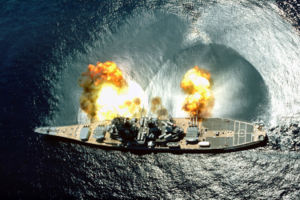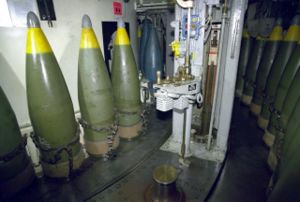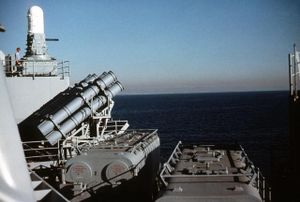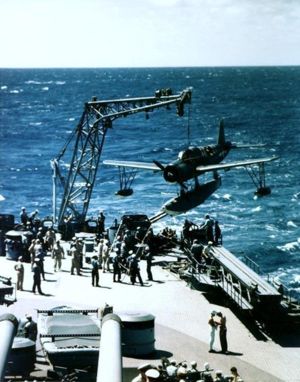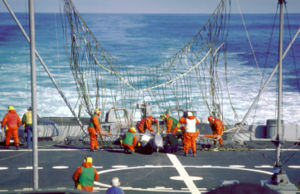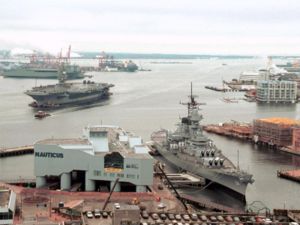Iowa class battleship
2007 Schools Wikipedia Selection. Related subjects: Military History and War
| Iowa-class battleship | |
|---|---|
 USS Wisconsin, the fourth ship of the class, in her Cold War configuration. |
|
| Class Overview | |
| Class type: | Battleship |
| Class name: | The State of Iowa |
| Preceded by: | South Dakota class |
| Succeeded by: | Montana class |
| Ships of the line: | Iowa (BB-61), New Jersey (BB-62), Missouri (BB-63), Wisconsin (BB-64) (not completed: Illinois (BB-65), Kentucky (BB-66)) |
| General Characteristics (USS Iowa) | |
| Displacement: | 45,000 tons (standard); 52,000 tons (mean war service); 56,500 tons (full load). |
| Length: | 861¼ ft between Perpendiculars; 890 ; ft overall (271.27 m) |
| Beam: | 108 ft (32.92 m) |
| Draft: | 36 ft (10.97 m) Maximum. |
| Speed: | 33 knots (61.12 km/h nominal);35 knots (64.82 km/h maximum); |
| Complement: | 2,700 officers and men (World War II, Korea and Vietnam), 1,800 officers and men (1980s) |
| Max. cruising radius | 9,600 miles (15,000 km) @ 25 knots (46 km/h); 16,600 miles (27,000 km) @ 15 knots (28 km/h) |
| Power: | 212,000 shp (158 MW) forward; 44,000 shp (33 MW) reverse; 8 Babcock & Wilcox Boilers. |
| Drive: | 4 screws; geared turbines; G.E. (BB-61;BB-63); West. (BB-62; BB-64; BB-66). |
| Fuel: | 9,033 tons oil (max) |
| Armor | Belt: 12.1 in (307 mm), Bulkheads: 11.3 in (287 mm), Barbettes: 11.6 to 17.3 in (295 to 439 mm), Turrets: 19.7 in (500 mm), Decks: 7.5 in (191 mm) |
The Iowa-class battleships were the biggest, the most powerful, and the last battleships built for the United States Navy. Four were built in the early 1940s for World War II; two more were laid down but were scrapped prior to completion. The four were decommissioned, then recommissioned in the 1980s, and decommissioned again in the 1990s.
Built with cost as no object "The Iowa-class fast battleships were arguably the ultimate capital ship in the evolution of the battleship." Yet even as these behemoths entered service they were being eclipsed by aircraft carriers as the most important naval vessels.
The Iowa-class battleships improved upon the earlier South Dakota class with more powerful engines, longer-caliber guns giving greater range, and an additional 200 feet (60 m) of length for improved seakeeping. The Iowas are widely considered to be amongst the most attractive battleships ever built, with a long, narrow, elegant bow and three powerful gun turrets. While excellent sea boats, the ships are quite wet forward owing to the long bow. Like all American battleships of their generation, their armament was laid out in two turrets before the superstructure and one after ("2-A-1"), with the 5 inch dual-purpose secondaries (anti-ship and anti-aircraft) flanking the superstructure. By battleship standards they were slender for their length, in order to be able to pass through the Panama Canal. This made them difficult to armor, especially forward, near the #1 turret. The ships are actually two feet wider than what is accepted in the present day as a Panamax configuration, only allowing a single foot of clearance either side of the hull. The follow-on Montana class battleships, had they been completed, would have been built to a post- Panamax design, having a beam 12 feet wider than the Iowas.
The Iowas were unique in several respects. First, they were designed as "fast" battleships, able to rely on an even mix of speed and firepower, and capable of sailing at the same speed as the carrier force. Second, although they had to be designed to fit through the Panama Canal, they took that to the limit, as described above. Third, all four of the Iowa class battleships were recommissioned and refitted under the Reagan Administration as part of Navy Secretary John F. Lehman's " 600-ship Navy" plan, particularly in response to the Soviet Navy commissioning the Kirov class battlecruisers/missile cruisers. Fourth, these ships were active, albeit intermittently, throughout the latter half of the 20th century. Lastly, all four ships still exist: this is unusual because the US Navy typically scraps older, decommissioned ships or sinks them in weapons tests.
Design history
The Iowa-class began in response to the need for fast escorts for aircraft carriers. The design process began in early 1938 on the basis of creating an extended South Dakota class. A study indicated that a 45,000 ton Extended-South Dakota would be capable of 33 knots. Another feature of the design was to be the Mark 2 16 inch(406 mm) / 50 caliber gun. This was originally intended to be the main armament of the cancelled battleships and battlecruisers of 1922. However, this gun was rejected in favour of the new Mark 7 16 inch(406 mm) / 50-caliber gun because of its lighter weight. The new gun had to be accepted because of a miscommunication between the Bureau of Ordnance and the Bureau of Construction and Repair resulting in the ship's barbettes being designed too small to support the heavier and bulkier Mark 2 guns. The Mark 7 was intended to fire the same 2,240 lb shell as the 16 inch/45-caliber gun but as the design was being completed a new 2,700 lb shell was developed. This led to problems with armor protection since the current armor was only designed to resist 2,240 lb shells. It was too late in the development to increase the armor as the increase in weight would have pushed the ship over the 45,000 ton limit. The design was then finalized and a contract was signed with the ship yards in July 1939. Originally BB-61, BB-62, and BB-63 were to be of the same design while BB-64, BB-65, and BB-66 were intended to be larger, slower ships mounting 12 16 inch guns. But by late in 1939 it was apparent that the navy needed as many fast battleships as possible and it was decided that, first, BB-64 alone, but then also BB-65 and BB-66, would follow the same design as their sisters.
Construction
The Iowa-class battleships were constructed at three Navy Yards: the New York Navy Yard in Brooklyn, New York, the Philadelphia Navy Yard in Philadelphia, Pennsylvania, and the Norfolk Navy Yard in Norfolk, Virginia. The New York Naval Yard built Iowa and Missouri, while the Philadelphia Navy Yard built New Jersey and Wisconsin. The last two ships, Illinois and Kentucky, were laid down in the Philadelphia Navy Yard and Norfolk Navy Yard, and construction continued until they were cancelled, in 1945 and 1947 respectively. According to some sources, Illinois and Kentucky were to be built to a slower (28 knot) standard, with increased protection both above and below the waterline.
- BB-61 USS Iowa was laid down on June 6, 1940, and was completed on February 22, 1943.
- BB-62 USS New Jersey was laid down on September 16, 1940; and completed on May 23, 1943.
- BB-63 USS Missouri was laid down on January 6, 1941; and completed on June 11, 1944.
- BB-64 USS Wisconsin was laid down on January 25, 1942; and completed on April 16, 1944.
- BB-65 USS Illinois was authorized in 1940, and ordered from the Philadelphia Navy Yard in December, 1942; but was cancelled when 22% complete on August 11, 1945.
- BB-66 USS Kentucky was laid down on December 6, 1944; and construction suspended on February 17, 1947. "Launched" on January 20, 1950 to clear drydock for repairs to USS Missouri. Sold for scrap on October 31, 1958. Bow used to replace the damaged bow of USS Wisconsin in 1956 and remains in place to this day.
- BB-62 USS New Jersey was laid down on September 16, 1940; and completed on May 23, 1943.
Armament
The Iowa-class ships were among the most heavily armed ships the United States ever put to sea. The main battery of 16 inch guns could hit targets nearly 24 miles (39 km) away with a variety of artillery shells, from standard armor piercing rounds to tactical nuclear charges called "Katies" (from "kt" for kiloton). The secondary battery, of much smaller caliber and shorter range, could inflict severe damage upon smaller ships. The ships were built with many 40 mm anti-aircraft guns, which were gradually replaced with missiles, electronic-warfare suites, and Phalanx anti-missile Gatling gun systems.
Main battery
The primary armament of an Iowa-class battleship is nine 16-inch (406 mm) / 50-caliber guns in three 3-gun turrets: two forward and one aft. The guns are 66 feet (20 m) long (50 times their 16-inch bore, or 50 calibers, from breechface to muzzle). About 43 feet (13 m) protrudes from the gun house. Each gun weighs about 239,000 pounds (108 000 kg), roughly the weight of a space shuttle. They fire projectiles weighing from 1,900 to 2,700 pounds (850 to 1,200 kg) at a maximum speed of 2,690 ft/s (820 m/s) up to 24 miles (39 km). At maximum range the projectile spends almost 1½ minutes in flight.
Only the top of the turret protrudes above the main deck. The turret extends either four decks (Turrets 1 and 3) or five decks (Turret 2) down. The lower spaces contain rooms for handling the projectiles and storing the powder bags used to fire them. Each turret required a crew of 77 to 110 men. The turrets are not actually attached to the ship, but sit on rollers, which means that if the ship were to capsize the turrets would fall out. (Underwater photos of the Bismarck show empty barbettes, vacated as the ship sank.)
The turrets are "three-gun," not "triple", because each barrel can be elevated independently; they can also be fired independently. The ship could fire any combination of its guns, including a broadside of all nine. Contrary to myth, the ships do not move much sideways when a broadside is fired. (For a more scientific exploration of this subject, see the link below.)
The guns can be elevated from −5° to +45°, moving at up to 12° per second. The turrets can be rotated about 300° at about four degrees per second and can even be fired back beyond the beam, which is sometimes called "over the shoulder." The guns are never fired directly forward (in the 1980s refit, a satellite uplink antenna was mounted at the bow).
The big guns were designed to fire the standard 16-inch (406 mm) artillery shells, but later advances brought more types of shell, including:
- The Mk. 8 APC (Armor-Piercing, Capped) shell mentioned in the above text, which weighs in at 2,700 lb (1225 kg) and was designed to penetrate the hardened steel armor carried by foreign battleships. At 20,000 yards (18 km) the Mk. 8 could penetrate 20-inch (500 mm) of steel armor plate. At the same range, the Mk. 8 could penetrate 21 feet (6.4 m) of reinforced concrete.
- For unarmored targets and shore bombardment, the 1,900-lb (862-kg) Mk. 13 HC (High-Capacity—referring to the large bursting charge) shell was available. The Mk. 13 shell would create a crater 50 feet (15 m) wide and 20 feet (6 m) deep upon impact and detonation, and could defoliate trees 400 yards (360 m) from the point of impact.
- "Katie" shells: Around 1953, the United States Navy began a top-secret program to develop Mk. 23 nuclear naval shells with an estimated yield of 15 to 20 kilotons. These shells were designed to be launched from the best seaborne artillery platform available, which at the time were the four ships of the Iowa class. The shells were reportedly ready by 1956; however, it is not known whether they were ever actually deployed on the Iowa-class battleships because the United States Navy does not confirm or deny the presence of nuclear weapons aboard its ships.
Secondary battery and anti-aircraft batteries
The secondary battery of the ship consists of 5 inch (127 mm) / 38-caliber guns in a series of twin mounts. Originally the secondary battery was intended to be part of the anti-aircraft defenses, but as aircraft became faster their effectiveness in that role decreased. Their use increased again toward the end of the war with the development of proximity-fuzed 5 inch shells that burst near the target rather than requiring a direct hit. By the time of the Gulf War the secondary battery was largely relegated to shore bombardment and littoral defense. Until the modernization in the 1980s there were ten twin mounts, five on each side of the ship. In the modernization the two mounts farthest aft on each side were removed to make room for missiles, leaving the ship with just six twin mounts. The guns have an effective range of 9 miles (14 km) and can be fired as fast as the crew can load and fire them. A good crew could run 16 to 23 rounds per minute through them.
The British attack at Taranto and the Japanese attack at Pearl Harbour made it clear that airpower was going to play a substantial role in the war. The Iowas were designed to be a fearsome anti-aircraft platform. When launched they carried twenty quad Bofors 40 mm gun mounts, and forty-nine Oerlikon 20 mm cannon single mounts. By the end of WWII, the single 20 mm had stopped being a very effective anti-aircraft weapon: it did not have enough punch to stop the bigger, heavier aircraft they were seeing, in particular the kamikazes. By 1950, almost all of the single 20 mm guns had been removed. In the modernization in the 1980s, the Navy realized that it is difficult to shoot down a jet with a 40 mm anti-aircraft gun, so all of the 40 mm gun mounts and the last of the 20 mm guns were removed in the modernization. In their place, the Navy installed four of the Phalanx Close-In Weapons Systems.
Missiles
During the modernization in the 1980s, three important weapons were added to the Iowa-class battleships. The first was the CIWS anti-aircraft/anti-missile system discussed above. The other two were missiles for use against both land and sea targets.
The Iowa class were fitted with an anti-ship cruise missile, the RGM-84 Harpoon, in 16 launch tubes located alongside the aft stack, eight per side in two pods of four. The Harpoon has a range of about 85 nautical miles (157 km) depending upon how it is fired. For increased range and accuracy against land targets the Iowa class gained 32 BGM-109 Tomahawk missiles located in eight Armored Box Launchers. The TLAM or Tomahawk Land-Attack Missile was used extensively in the Gulf War by USS Missouri and USS Wisconsin. During the war, Wisconsin served as the TLAM strike commander for the Persian Gulf, directing the launches that marked the opening of Operation Desert Storm. To make room for the missile launchers, four of the ship's ten 5"/38 DP mounts were removed (little sacrifice, as the old guns were far less useful than the longer-barreled 5"/54 mounts on modern ships, and even less useful than the missiles that replaced them).
A planned installation of RIM-7 Sea Sparrow was scrapped because no shock-absorbing mounting could be designed that would protect the missiles' radar from damage when the guns fired.
Aircraft
Like most later battleships, the Iowas used aircraft for reconnaissance and gunnery spotting.
The early aircraft were floatplanes launched from catapults on the ship's fantail. Upon completion of their mission, they landed on the water, taxied up to the stern of the ship, and were lifted by a crane back to the catapult. Initially, the Iowas carried the Vought OS2U Kingfisher, a lightly armed two-man aircraft used exclusively for reconnaissance and gunnery spotting. Typically an Iowa-class battleship would carry three: two on the catapults and a spare on a trailer nearby. At the beginning of 1945, the Kingfisher was replaced by the single-seat Curtiss SC Seahawk floatplane.
Around 1949, the Iowa class no longer had to conduct the dangerous work of launching and recovering floatplanes, as helicopters were brought aboard for reconnaissance, gunnery-spotting, and search-and-rescue missions. The first helicopters were operated from the top of Turret 2; the fantail was still too crowded. Presently, the catapults were removed and helicopter operations moved aft to the fantail.
As the Iowa class entered the 1990s, they had a new tool available for reconnaissance and gunnery-spotting; as many as eight RQ-2 Pioneer unmanned aerial vehicles (UAVs). Sometimes referred to as remote piloted vehicles (RPVs), these were unmanned aircraft piloted by remote control. Launched from the fantail using a rocket-assist booster that was discarded shortly after takeoff, a Pioneer used an aft-mounted, push-propeller engine to achieve speeds of up to 90 mph (40 m/s) with a mission endurance of about four hours. Because it is difficult to land the Pioneer without damaging itself or the ship, a large net is strung up for recovery as for a volleyball game, and the aircraft is flown into it.
The Pioneer carries a video camera in a pod under the belly of the aircraft, which transmits live video back to the ship so that the operators can observe enemy actions or fall of shot during naval gunnery. The Pioneers saw extensive use by the USS Missouri and USS Wisconsin during the Gulf War. The latter became the first ship ever to have enemy forces surrender to a remotely controlled observation drone.
Engineering plant
The Iowa-class battleships are the fastest battleships ever launched, capable of sustained speeds of 33 knots (61 km/h) or better. The engineering plant consists of four General Electric double-expansion steam turbine engines, each driving a single shaft that turns one screw. The two outboard screws on the Iowa class have four blades and are just over 18 feet (5.5 m) in diameter. The two inboard screws have five blades and are about 17.5 feet (5.3 m) in diameter.
Eight Babcock and Wilcox M-Type boilers heat water in tubes to more than 800 °F (430 °C), producing 650 psi (4500 kPa) steam.
The double-expansion engines consist of a high-pressure (HP) turbine and a low-pressure (LP) turbine. The steam is first passed through the HP turbine which turns at up to 2100 rpm. The steam, largely depleted at this point, is then passed through a large conduit to the LP turbine. By the time it reaches the LP turbine, it has no more than 50 psi (300 kPa) of pressure left. The LP turbine increases efficiency and power by extracting the last little bit of energy from the steam.
After leaving the LP turbine, the exhaust steam passes into a condenser and is then returned as feed water to the boilers. Water lost in the process is replaced by three evaporators, which can make a total of 60,000 US gallons per day (3 liters per second) of fresh water. After the boilers have had their fill, the remaining fresh water is fed to the ship's potable water systems for drinking, showers, hand washing, cooking, etc. All of the urinals and all but one of the toilets on the Iowa class flush with saltwater in order to conserve fresh water.
The turbines, especially the HP turbine, can turn at 2,000 rpm; their shafts drive through reduction gearing that turns the propellor shafts at speeds up to 225 rpm, depending upon the desired speed of the ship.
Electricity
Electricity drives many systems aboard ship, including rotating the turrets and elevating the guns. Each of the four engine rooms has a pair of Ship's Service Turbine Generators (SSTGs) manufactured by Westinghouse. Each SSTG generates 1.25 MW for a total of 10 MW of electricity. The SSTGs are powered by steam from the same boilers that feed the engines. For backup, the ship also has a pair of 250- kW diesel generators.
To allow battle-damaged electrical circuits to be repaired or bypassed, the lower decks of the ship have a Casualty Power System whose large 3-wire cables and wall outlets called "biscuits" can be used to reroute power.
Reactivation potential
The United States long maintained Iowa and Wisconsin in reserve and could have recommissioned one or both of them. The cost was priced at $430 million for a 14-month program or $500 million for a 10-month program. Among other things, fitting the ships to fire Tomahawks would be costly. Their Armored Box Launchers cannot fire today's Tomahawks, which are designed for modern ships' Vertical Launch System (VLS) launcher.
The Navy has nearly 15,000 16 inch (406 mm) shells, but has not manufactured them since the 1960s.
The two ships were maintained in accordance with the National Defense Authorization Act of 1996, which includes the following battleship readiness requirements:
- List and maintain at least two Iowa-class battleships on the Naval Vessel Register that are in good condition and able to provide adequate fire support for an amphibious assault;
- Retain the existing logistical support necessary to keep at least two Iowa-class battleships in active service, including technical manuals, repair and replacement parts, and ordnance; and
- Keep the two battleships on the register until the Navy certified that it has within the fleet an operational surface fire support capability that equals or exceeds the fire support capability that the Iowa-class battleships would be able to provide for the Marine Corps' amphibious assaults and operations ashore. (Section 1011)
The U.S. Navy had originally planned to keep the two battleships on the Naval Vessel Register until new naval surface fire support guns and missiles enter service between 2003 and 2008.
On March 17, 2006, the Secretary of the Navy, acting with the authority granted by the 2006 defense appropriations act, struck Iowa and Wisconsin from the Register. They are likely to be transferred to a museum association, as were Missouri and New Jersey.
Reactivation debate
Some have argued that the U.S. military needs the battleships and their 16 inch guns.
Some United States Marine Corps leaders have fought to get both battleships recommissioned. They argue that adequate fire support for an amphibious assault or onshore operations cannot be provided by existing weapons, the Navy's planned naval surface fire support guns and missiles, or the DD(X) destroyer, which will not arrive until 2013.
Battleship proponents argue that cannon-fired shells would be more cost-effective at hitting coastal targets than missiles or bombs dropped from aircraft. They say guidance packages and rocket boosters make today's shells more accurate and longer-ranged than their predecessors.
Detractors say:
- Few coastal targets are hardened enough to withstand missile strikes.
- Amphibious assault techniques have improved since World War II, rendering obsolete heavy bombardments and mass assaults against built-up chokepoints. During the 2001 invasion of Afghanistan, the United States executed an amphibious entry against a landlocked nation, using a supercarrier ( Kitty Hawk) as a sort of super- amphibious assault ship.
- A single round that destroys an enemy command centre so the enemy cannot see that the invasion force is landing somewhere else is as effective at protecting troops.
- Battleships are disproportionately vulnerable to mine and submarine warfare. During the 1991 Gulf War, mines in Iraq's coastal waters limited the operations of Wisconsin and Missouri. Some of the most effective shore fires from that war were carried out by Oliver Hazard Perry-class frigates armed with 76 mm guns.
- In order to fire modern Tomahawk missiles, the battleships would need to be equipped with Vertical Launching System emplacements, which would require a far more expensive rebuild than the old Armored Box Launchers, and might require cutting holes in the ship's armor deck, possibly compromising structural integrity.
- Battleships cannot be equipped with modern electronics, which would be damaged or destroyed by the shock of the 16 inch guns' fire, reducing or eliminating their interoperability with the rest of the fleet.
- Adding two 1,500-man battleships would exacerbate the Navy's chronic manpower shortfall.
Locations
Currently, three of the ships are on display at the following locations:
- USS New Jersey
- On October 14, 2001, USS New Jersey opened as a museum at Camden, New Jersey.
- USS Missouri
- Located 500 yards (about 450 meters) from USS Arizona at Pearl Harbour, Missouri was opened as a museum on 29 January 1999. The museum is operated by the USS Missouri Memorial Association, a non-profit organization.
- USS Wisconsin
- Berthed in Norfolk, Virginia as a museum ship at the Hampton Roads Naval Museum. Wisconsin was originally struck from the naval register, but her name was restored 12 February 1998. Her weather decks are currently open to the public; however, the ship is still owned and operated by the Navy, and maintained as part of the United States' mothball fleet.
The remaining ship of the class, USS Iowa, is currently part of the Naval Reserve Fleet and is currently berthed at Suisun Bay near San Francisco. In 2005, San Francisco's city council members, citing opposition to the Iraqi war and the U.S. Governments requirements on the Navy's policies regarding homosexuals, voted 8-3 against maintaining Iowa, paving the way for Stockton, California, to acquire the battleship. Currently, Iowa is the only ship of her class not open to the public as a museum.
Competition
Historians and ship buffs debate which of the world's battleships might have been the closest competitors to the Iowa class, assessing performance using such factors as battle history, gun size, and armor.
Some U.S. contenders include the Colorado class battleships, the first U.S. vessels to mount 16 inch guns; the North Carolina class, the first U.S. ships designated as "fast battleships"; and the South Dakota class, from which the Iowas were developed.
Three other contenders were never built:
- The Imperial Japanese Navy's "Super Yamato"-class battleships, with 20 inch guns. Two were planned.
- The U.S. Navy's Montana-class battleships, mounting four turrets with twelve of the 16 inch guns used on the Iowa-class. Five were planned.
- The Soviet Navy's Sovetsky Soyuz class battleships, laid down in the late 1930s but never completed in the wake of the German invasion of the Soviet Union. They would have been considerably larger than the Iowa-class battleships, though they would have carried similar main armament.
